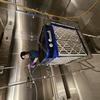Indoor Air Quality and Ventilation Group
The Indoor Air Quality and Ventilation Group develops computer simulation programs and measurement procedures and applies them to better understand the phenomena of air and contaminant transport in buildings and to support industry efforts to improve indoor conditions in buildings in a cost-effective manner. The results of this research are providing reliable methods and to evaluate ventilation characteristics and indoor pollutant concentrations
The modeling efforts include the development and application of multizone airflow and indoor air quality models, specifically the CONTAM series which predicts airflows and contaminant concentrations in multizone building systems. CONTAM is based on a graphic interface that allows the user to draw floor plans on a "sketchpad" and employ "icons" to represent airflow paths, ventilation system components, and contaminant sources. CONTAM has been used at NIST to study the indoor air quality impacts of HVAC systems in single-family residential buildings, ventilation in large mechanically-ventilated office buildings, and radon entry and transport in large residential, office, and school buildings.
Measurement procedures are being developed and demonstrated to evaluate building ventilation and indoor pollutant concentrations. These procedures range from sophisticated tracer gas methods used predominantly in building research efforts to less involved procedures that can be employed by building operators. NIST researchers are continually developing new test procedures, and then demonstrating them in the field to evaluate their feasibility and reliability. The efforts in which these procedures are demonstrated in the field has resulted in the development of an important database of building ventilation and indoor air quality performance.
Staff Directory
News and Updates
Projects and Programs
Publications
Software
Awards
Contacts
-
(301) 975-4853











